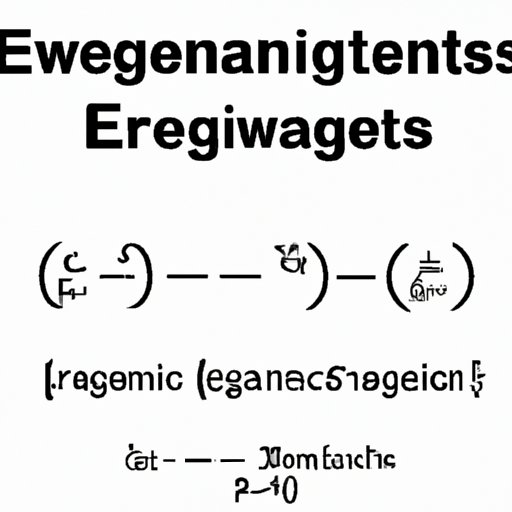
I. Introduction
Eigenvectors are a fundamental concept in linear algebra that plays a crucial role in various fields, including mathematics, physics, and computer science. Eigenvectors refer to a special type of vectors that do not change direction when a linear transformation is applied to them. Instead, they undergo a scalar multiplication known as an eigenvalue. In this article, we will explore how to find eigenvectors, their real-life applications, top tools available for this purpose, common misconceptions, and FAQs.
II. Step-by-Step Guide
Finding eigenvectors involves several steps. Firstly, we must identify the matrix’s eigenvalues, which are the scalar values that make a matrix singular. To do that, we subtract a scalar multiple of the identity matrix from the matrix itself and compute the determinant, hence solving the equation. Then, for each eigenvalue, we find the associated eigenvector by solving a linear system of equations.
Let’s take an example to understand this better. Consider the 2×2 matrix, A = [3 2; 4 1]. Firstly, we need to solve the characteristic equation associated with this matrix by computing det(A – λI), where I is the identity matrix, and λ is the eigenvalue. Thus, we have det(A – λI) = 0 => det([3-λ 2; 4 1-λ]) = 0. By computing the determinant, we get λ² – 4λ – 5 = 0. Solving the quadratic equation, we get λ1 = 5 and λ2 = -1.
Next, we find the eigenvectors:
For λ1 = 5, (3-5)x + 2y = 0 and 4x + (1-5)y = 0. By solving these two linear equations, we can conclude that the associated eigenvector is [-2; 1].
For λ2 = -1, (3+1)x + 2y = 0 and 4x + (1+1)y = 0. By solving these two linear equations, we can conclude that the associated eigenvector is [1; 2].
Therefore, the eigenvectors of matrix A are [-2; 1] and [1; 2].
For higher-order matrices, the process is similar but involves solving higher-degree polynomial equations to obtain the eigenvalues and calculating the corresponding eigenvectors via linear systems of equations.
III. Real-Life Applications
Eigenvectors find their applications in various fields such as physics, computer science, and statistics. In physics, eigenvectors are used to determine the quantum states of a system, and in computer science and machine learning, they are used for dimensionality reduction, image compression, and object recognition. In statistics, eigenvectors underlie principal component analysis, a technique used to identify underlying structures in data.
For example, suppose we take the scenario of face recognition by a computer system. A person’s face can be represented as an array of pixels, typically a high-dimensional vector. By computing eigenvectors of the pixel distribution with the highest variance, we can identify the most significant components to create a lower-dimensional representation of the image. This technique is used for facial recognition in applications such as security systems and social media image tagging.
IV. Top Tools
Several software tools are available for finding eigenvectors, such as MATLAB, Mathematica, R, and Python. MATLAB’s built-in function “eig” directly computes the eigenvalues and eigenvectors of a matrix, while Mathematica’s “Eigensystem” returns both the eigenvalues and eigenvectors of a matrix.
Similarly, in R, the function “eigen” performs the same task, and in Python, the package NumPy provides the “eig” function. These software tools come with their Graphical User Interface (GUI) and provide efficient and straightforward ways to find eigenvectors.
V. Mythbusters-Style Article
One common misconception about finding eigenvectors is that the process is complicated and not relevant in real-life situations. This myth could not be further from the truth. While the process may involve several steps and calculations, its real-life applications and importance make it a critical concept to understand.
Another myth is that eigenvector calculations are only used in theoretical applications and have no practical significance. As we have seen previously, eigenvectors have several practical applications, such as in image recognition and data analysis. Therefore, understanding eigenvectors and their significance can be a valuable trait for professionals in the field of mathematics, physics, and computer science.
VI. FAQs
1. What is the difference between eigenvalue and eigenvector?
Eigenvalue is a scalar value that scales the eigenvector to produce a new vector. In contrast, eigenvector refers to a vector that does not change its direction when a linear transformation is applied to it.
2. Why are eigenvectors important?
Eigenvectors are important because they provide the most significant direction or axis of deformation in a linear transformation. They also find various applications in physics, computer science, and statistics.
3. What are the prerequisites for learning eigenvectors?
To learn eigenvectors, one must have a basic understanding of matrix algebra, linear transformations, vectors, and determinants.
VII. Conclusion
In conclusion, learning how to find eigenvectors is an essential concept in linear algebra and has various applications in real-life situations, including machine learning, image recognition, physics, and statistics. Several software tools are available to find eigenvectors, and they provide an efficient and straightforward way to calculate them. Understanding the significance and application of eigenvectors is critical for professionals in mathematics, physics, and computer science. We hope this article has been informative and encourages readers to explore further applications of eigenvectors.




